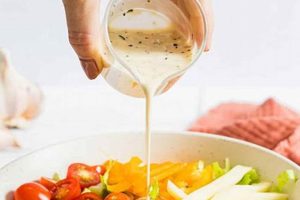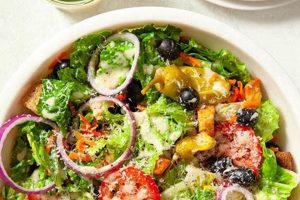A basic vinaigrette, often composed of oil, vinegar, and seasonings, forms the foundation of numerous salads. For example, a straightforward blend of olive oil, lemon juice, salt, and pepper can elevate fresh greens and vegetables. Variations can include additions such as Dijon mustard, honey, or minced herbs. These uncomplicated dressings offer a healthy and flavorful alternative to commercially produced options, often laden with additives and preservatives.
Fresh, homemade dressings contribute significantly to both the nutritional value and overall enjoyment of a salad. They allow for control over ingredients, catering to dietary restrictions and preferences. Historically, simple dressings predate complex bottled varieties, reflecting culinary traditions that emphasize fresh, readily available components. This focus on simplicity aligns with modern healthy eating trends that prioritize whole foods and minimize processed ingredients.
This exploration of fundamental salad dressings will cover a range of easy-to-prepare recipes, suitable for various occasions and palates. Discussions will encompass ingredient selection, techniques for emulsification, and suggested pairings of dressings with different salad components.
Tips for Creating Delicious, Simple Salad Dressings
Flavorful salads often begin with a well-crafted dressing. These tips offer guidance on creating simple yet impactful dressings at home.
Tip 1: Start with high-quality ingredients. The flavor of a dressing directly reflects the quality of its components. Opt for extra virgin olive oil, fresh citrus juice, and quality vinegar for optimal results. Freshly ground pepper and sea salt further enhance the taste.
Tip 2: Balance flavors effectively. A successful dressing hinges on a harmonious blend of acidity, sweetness, and savory notes. Achieve this balance through careful adjustments of vinegar or citrus juice, a touch of honey or maple syrup, and seasonings like Dijon mustard or minced garlic.
Tip 3: Emulsify properly. A stable emulsion prevents the dressing from separating. Whisk the ingredients vigorously or use a blender to create a creamy, cohesive texture. A small amount of Dijon mustard can act as an emulsifier, helping to bind the oil and vinegar.
Tip 4: Taste and adjust seasoning. Palates vary, so tasting and adjusting seasoning is crucial. Start with a small amount of salt and pepper, then gradually add more until the desired flavor profile is achieved. Consider the other ingredients in the salad when adjusting seasonings.
Tip 5: Experiment with different oils and vinegars. Olive oil is a classic choice, but other oils like avocado or walnut oil offer distinct flavors. Explore various vinegars, such as balsamic, apple cider, or red wine vinegar, to discover new taste combinations.
Tip 6: Incorporate fresh herbs. Fresh herbs like chives, parsley, mint, or dill add depth and complexity to simple dressings. Chop them finely and add them just before serving to maximize their flavor and aroma.
Tip 7: Store dressings properly. Homemade dressings can be stored in an airtight container in the refrigerator for up to a week. Allow the dressing to come to room temperature before serving to enhance its flavor.
By following these tips, one can consistently create delicious and healthy homemade dressings that elevate any salad. These simple yet effective techniques empower individuals to personalize their salads and enhance culinary experiences.
This foundation in fundamental dressing preparation provides a gateway to more complex recipes and techniques, allowing for further culinary exploration.
1. Fresh, Quality Ingredients
The foundation of a truly exceptional simple salad dressing rests upon the selection of fresh, high-quality ingredients. The inherent flavors of these components shine through in uncomplicated recipes, emphasizing the importance of sourcing the best possible products. Subpar ingredients can result in a bland or unbalanced dressing, diminishing the overall salad experience.
- Oils
The choice of oil significantly impacts a dressing’s flavor and texture. Extra virgin olive oil, known for its robust flavor and health benefits, is a staple. Other options, such as avocado oil (with its mild, buttery taste), or walnut oil (offering a more distinct, nutty profile), provide variety. Selecting high-quality oils, ideally cold-pressed and unrefined, ensures optimal flavor and nutritional value.
- Vinegars
Vinegar provides the essential acidic element, balancing the richness of the oil. A wide array of vinegars offers diverse flavor profiles. Balsamic vinegar lends a sweet, tangy complexity, while apple cider vinegar contributes a bright, slightly fruity note. Red wine vinegar offers a more robust, assertive tartness. Using quality vinegars elevates the overall complexity of the dressing.
- Citrus Juices
Freshly squeezed citrus juice, such as lemon or lime, delivers a vibrant acidity and a refreshing brightness to dressings. These juices also contribute aromatic complexity, enhancing the overall sensory experience. Using fresh juice, as opposed to bottled concentrates, ensures a cleaner, more vibrant flavor.
- Seasonings
High-quality seasonings complete the dressing. Freshly ground black pepper offers a more intense aroma and flavor compared to pre-ground pepper. Sea salt, with its subtle mineral notes, enhances the other ingredients without overpowering them. Fresh herbs, like chives, parsley, or mint, add a final layer of flavor and freshness. These small additions contribute significantly to the overall quality and complexity of the final product.
Investing in fresh, high-quality ingredients for a simple salad dressing ensures an elevated culinary experience. The synergy between these carefully selected components allows their individual flavors to shine, resulting in a dressing that complements and enhances the other salad ingredients rather than masking them. The simplicity of the recipe allows the quality of the ingredients to take center stage, demonstrating that even with minimal effort, a delicious and healthy dressing can be achieved.
2. Balanced Flavor Profiles
Achieving a harmonious balance of flavors is paramount in crafting a successful simple salad dressing. A well-balanced dressing not only complements the salad ingredients but also elevates the overall dining experience. This balance relies on the careful interplay of acidity, sweetness, saltiness, and other nuanced flavors. Understanding these elements and their interactions is crucial for creating dressings that are both flavorful and versatile.
- Acidity
Acidity, primarily derived from vinegar or citrus juice, provides a bright, sharp counterpoint to the richness of the oil. It awakens the palate and adds a refreshing quality to the dressing. The level of acidity should be carefully considered; too much can be overpowering, while too little can result in a bland, oily dressing. Examples include the sharp tang of lemon juice in a vinaigrette or the mellow acidity of apple cider vinegar in a slaw dressing. The appropriate level of acidity depends on the other ingredients in the salad and the desired overall flavor profile.
- Sweetness
A touch of sweetness can balance the acidity and add depth of flavor. Honey, maple syrup, or even a pinch of sugar can contribute a subtle sweetness that rounds out the other flavors. This sweetness should be used judiciously, as too much can make the dressing cloying. A small amount of honey in a lemon vinaigrette, for example, can temper the sharpness of the lemon and create a more complex flavor profile. The sweetness also complements the natural sweetness of vegetables like carrots or beets.
- Saltiness
Salt is essential for enhancing the other flavors in the dressing. It should be used in moderation to avoid overpowering the delicate balance of flavors. Sea salt, with its nuanced mineral notes, is often preferred over table salt. The right amount of salt amplifies the other ingredients and brings the flavors into focus. It’s important to taste and adjust the salt level throughout the preparation process, as the other ingredients can influence the perceived saltiness.
- Other Flavor Enhancers
Beyond the core elements of acidity, sweetness, and saltiness, other ingredients can contribute complexity and depth to a simple dressing. Dijon mustard adds a subtle tang and helps emulsify the dressing. Minced garlic or shallot introduces a pungent savory note. Fresh herbs, such as chives, parsley, or dill, provide a burst of freshness and aroma. These additions should be used strategically to complement the other flavors and create a well-rounded profile. For instance, a touch of Dijon in a vinaigrette adds a subtle complexity that complements the acidity of the vinegar and the richness of the oil.
Mastering the balance of these flavor profiles is key to creating a simple dressing that elevates a salad from ordinary to extraordinary. By understanding the interplay of these elements, one can create dressings that are not only delicious but also adaptable to a wide range of salad ingredients and personal preferences. The simplicity of the dressing allows these core flavors to shine, creating a harmonious culinary experience.
3. Proper Emulsification
Proper emulsification is crucial for the stability and sensory appeal of simple salad dressings. Emulsification refers to the process of combining two immiscible liquids, typically oil and vinegar, into a homogenous mixture. Without proper emulsification, the dressing will separate, resulting in an oily layer on top and a watery layer beneath. This not only affects the dressing’s appearance but also its flavor and texture. A properly emulsified dressing clings evenly to salad ingredients, ensuring a consistent flavor distribution with each bite. Furthermore, the creamy texture achieved through emulsification enhances the overall sensory experience.
Several factors influence the stability of an emulsion. Vigorous whisking or blending provides the mechanical force needed to disperse the oil droplets throughout the vinegar. Ingredients like Dijon mustard or egg yolk act as emulsifiers, containing compounds that help bind the oil and vinegar together. These emulsifiers reduce surface tension between the two liquids, promoting a stable and uniform mixture. For example, in a classic vinaigrette, the Dijon mustard helps create a creamy, emulsified dressing that doesn’t separate quickly. Conversely, a simple oil and vinegar dressing without an emulsifier will separate rapidly, requiring re-whisking before each use.
Understanding the principles of emulsification empowers one to create simple, yet high-quality salad dressings. Achieving a stable emulsion ensures a visually appealing, flavorful, and texturally satisfying dressing. This impacts the overall enjoyment of the salad, demonstrating that even seemingly minor details, like proper emulsification, contribute significantly to culinary success. The practical application of this knowledge allows for greater control over the final product and enhances one’s ability to create dressings tailored to specific preferences and salad combinations.
4. Versatile Applications
The simplicity of a well-crafted salad dressing contributes significantly to its versatility. A basic dressing, built on a foundation of quality oil, vinegar, and seasonings, can be adapted to complement a wide array of salads and other dishes. This adaptability stems from the dressing’s balanced flavor profile, which enhances rather than overpowers other ingredients. Examining the various applications of these simple dressings reveals their value in diverse culinary contexts.
- Variety of Greens
Simple dressings pair well with a wide spectrum of leafy greens, from delicate butter lettuce and spinach to robust kale and romaine. The dressing’s balanced acidity and flavor profile enhance the natural flavors of the greens without masking their unique characteristics. A lemon vinaigrette, for example, complements the peppery bite of arugula as effectively as it enhances the subtle sweetness of butter lettuce.
- Beyond Leafy Greens
The application of simple dressings extends beyond traditional leafy green salads. These dressings can enhance grain bowls, roasted vegetables, pasta salads, and even grilled proteins. Their versatility stems from their ability to provide a balanced flavor foundation that complements diverse ingredients. A simple balsamic vinaigrette, for instance, can elevate roasted root vegetables or add a bright counterpoint to grilled chicken.
- Customization and Adaptability
Simple dressings offer a blank canvas for culinary creativity. Their fundamental structure allows for easy customization based on personal preferences or the specific components of a dish. Adding fresh herbs, spices, or a touch of sweetness can transform a basic vinaigrette into a dressing tailored to a specific culinary need. A simple vinaigrette can be customized with chopped cilantro and lime juice for a Mexican-inspired salad or with Dijon mustard and tarragon for a classic French flavor profile.
- Seasonal Adaptations
The versatility of simple dressings allows for seasonal adaptations. Incorporating seasonal produce into the dressing itself, or pairing the dressing with seasonal salad ingredients, maximizes flavor and freshness. A spring salad might feature a strawberry vinaigrette, while a summer salad could benefit from a basil-infused dressing. These seasonal variations demonstrate the adaptability of simple dressings and their capacity to enhance the culinary experience throughout the year.
The adaptability of simple salad dressings makes them a valuable asset in any kitchen. Their ability to complement a wide range of ingredients, coupled with the ease of customization, underscores their utility in diverse culinary scenarios. From everyday meals to more elaborate culinary creations, these versatile dressings provide a foundation of flavor that enhances the overall dining experience.
5. Easy Preparation
Ease of preparation is a defining characteristic of simple salad dressings, directly influencing their appeal and practicality. The minimal time and effort required allow for frequent preparation, promoting healthier eating habits by encouraging the consumption of fresh salads over processed alternatives. This ease of creation stems from the limited number of ingredients and straightforward techniques involved. A basic vinaigrette, for example, requires only oil, vinegar, and seasonings, whisked together in minutes. Such simplicity contrasts sharply with more complex dressings requiring specialized ingredients or elaborate procedures.
The accessibility of simple dressings further underscores their value. Minimal culinary expertise is needed, empowering individuals to create flavorful, healthy additions to their meals regardless of cooking experience. This accessibility contributes to dietary autonomy, allowing individuals to control ingredients and avoid additives common in commercial dressings. Furthermore, the quick preparation time makes these dressings ideal for busy lifestyles, offering a nutritious and flavorful option without demanding extensive time commitments. This practicality translates to greater consistency in healthy eating habits, demonstrating the significant impact of ease of preparation on overall dietary choices.
The connection between easy preparation and simple salad dressings is fundamental to their widespread adoption. This characteristic removes barriers to healthy eating, facilitating the incorporation of fresh produce into regular meals. The simplicity of these dressings, coupled with their adaptability and nutritional benefits, establishes them as a valuable tool for promoting balanced and sustainable dietary practices. This understanding reinforces the significance of prioritizing simple, readily accessible recipes in promoting healthier lifestyles.
Frequently Asked Questions About Simple Salad Dressings
This section addresses common inquiries regarding the preparation and utilization of simple salad dressings, providing practical guidance for achieving optimal results.
Question 1: What is the ideal ratio of oil to vinegar in a basic vinaigrette?
A common starting point is a 3:1 ratio of oil to vinegar. However, this can be adjusted based on personal preference and the specific types of oil and vinegar used. A milder vinegar may allow for a 2:1 ratio, while a more assertive vinegar might benefit from a 4:1 ratio. Experimentation is key to finding the perfect balance.
Question 2: How can one prevent homemade dressings from separating?
Vigorous whisking or blending helps create a more stable emulsion. Adding an emulsifier, such as Dijon mustard or honey, also aids in binding the oil and vinegar together. If separation occurs, simply re-whisk or blend the dressing before serving.
Question 3: What are some healthy alternatives to traditional oils in salad dressings?
Avocado oil, with its neutral flavor and high smoke point, is a healthy alternative. Other options include flaxseed oil, rich in omega-3 fatty acids, or walnut oil, which offers a distinct nutty flavor. These oils provide varied nutritional benefits and flavor profiles.
Question 4: How long can homemade salad dressings be stored?
Stored in an airtight container in the refrigerator, most homemade dressings will last for up to a week. Always check for any signs of spoilage before using. Allowing the dressing to come to room temperature before serving enhances its flavor.
Question 5: Can simple dressings be used for more than just salads?
Absolutely. Simple dressings are incredibly versatile. They can be used to marinate vegetables or proteins, as a dipping sauce for bread, or to add flavor to grain bowls, pasta salads, and roasted vegetables.
Question 6: How can one adjust the flavor of a simple dressing without overpowering it?
Start with small adjustments. Add a pinch of salt, a squeeze of lemon, or a dash of honey to incrementally adjust the flavor profile. Tasting frequently throughout the process helps prevent over-seasoning and ensures a balanced outcome.
By understanding these fundamental aspects of simple salad dressing preparation, one can consistently create delicious and healthy additions to a variety of dishes. Experimentation with different ingredients and flavor combinations encourages culinary exploration and personalized culinary experiences.
This concludes the frequently asked questions section. The following section will provide a collection of simple and delicious salad dressing recipes.
Simple Salad Dressing Recipes
Exploration of simple salad dressing recipes reveals their significant contribution to both flavor and nutrition. Emphasis on fresh, high-quality ingredients, balanced flavor profiles, proper emulsification techniques, versatile applications, and ease of preparation underscores their value in a wide range of culinary settings. From classic vinaigrettes to innovative variations, these dressings offer a customizable and accessible approach to healthy eating.
Culinary exploration of simple salad dressings empowers individuals to create flavorful, healthful meals with minimal effort. Continued experimentation with diverse ingredients and flavor combinations promises further enhancement of culinary experiences. Prioritizing fresh, readily available components promotes sustainable dietary practices, contributing to long-term health and well-being through accessible and enjoyable culinary endeavors.






